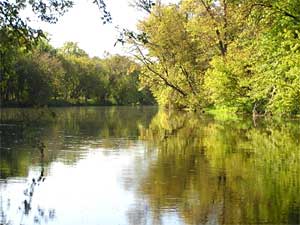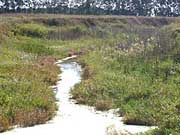| Polluted waters: A long and costly cleanup |
 |
| The Sauk River flows for 90 miles through central Minnesota. Some people know it as a great route for canoeing, but it's also polluted with fecal coliform bacteria, phosphorous and sediment. (MPR Photo/Tim Post) |
Collegeville, Minn. — A thin ribbon of wilderness cuts through a busy industrial area in Waite Park, just west of St. Cloud. Scout out a clearing on the edge of town, follow a short path through the woods, and you'll find the Sauk River.
This river starts at Sauk Centre and meanders across the rural dairy country of Stearns County. After 90 river miles, it empties into the Mississippi at St. Cloud.
Julie Klocker has canoed this river many times.
"You see almost no buildings, businesses, animals, anything. It's like this jewel of wilderness in an area that's rapidly urbanizing," Klocker said.
Standing by the river, under a thick canopy of trees, this is a tranquil scene. But a close look shows problems with the water. As the river flows swiftly by, it's light brown in color, like coffee with cream.
Julie Klocker is a fan of this stretch of river, but admits it has problems. She should know. She's with the Sauk River Watershed District, an organization charged with monitoring the 1,000 square miles of rivers and lakes in the region.
The Sauk River is polluted with sediment, phosphorous, nitrates and fecal coliform bacteria. The pollution comes from failing septic systems, leaking livestock feedlots, and urban runoff.
Klocker says whatever is in this water comes from hundreds of streams and lakes draining into the Sauk.
"What you see here -- we've created this in a large part," Klocker said.
This river is so polluted, the Minnesota Pollution Control Agency considers it too dirty to safely swim and fish.
Klocker's organization has spent 20 years trying to improve the Sauk River. The group has paid farmers to take land out of production near the river, to create a buffer that prevents runoff and soaks up pollutants. It's offered low interest loans to homeowners so they can fix up leaking septic systems. In all, the group has spent nearly $4 million. But that's pocket change compared to what they need.
"Hundreds of millions of dollars just in this watershed," says Klocker. "Sometimes you deal with it best by not thinking of the magnitude of the problem and the need that's out there."
The MPCA has studied less than one-fourth of the state's waterways, so no one is sure just how bad the pollution problem really is. But state officials estimate that somewhere between 30 and 40 percent of Minnesota's lakes and rivers are significantly polluted. Since Minnesota has nearly 12,000 lakes, and almost 70,000 miles of rivers and streams, the cleanup cost is hard to comprehend.
Assistant PCA Commissioner Lisa Thorvig offers up a staggering guess.
"We estimated a need of about $3 billion to clean up our lakes and rivers and streams from non-point source pollution," Thorvig said.
Non-point source pollution is hard to track down. It's the little things people do that end up hurting water quality. It can come from farm field runoff, but also when someone fertilizes their lawn or washes their car in the driveway.
Cleaning up non-point source pollution is expensive. Dredging doesn't work, because you can't scoop contaminants out of a river. The pollution spigot has to be turned off. That means working with each landowner along a waterway to stop polluted runoff from their property, and that can get costly.
It's something Thorvig says the MPCA only spends $7 million a year on now.
"So clearly we are falling behind. There's very little money available for the cleanup, which is the biggest need," said Thorvig. "If you list waters and you study them and you know what the plan is, but there is no funding to actually clean up the waters, that's not really what Minnesotans want."
According to Thorvig, the plan to clean up Minnesota's polluted lakes and rivers needs to include a lot of different organizations and people. And all of the money doesn't need to come from the state.
Money can be used strategically to leverage further grants from the federal government. Cleanup efforts will also rely on the occasional donation of money and lots of volunteer work.
Mary Hoppe is one of those folks who's doing her part to protect the river near where she lives. Hoppe's house, south of New Munich in central Minnesota, sits on several acres bordered by the twisting Sauk River. Unlike the Sauk's muddy appearance downstream, here the river flows much cleaner. It's so clear in spots you can see pebbles on the river bottom.
"It's beautiful," Hoppe said, standing by the river. "The water is always so serene and calming, its kind of an emotional thing I think."
When Hoppe first moved here in the late 1990s, she noticed a big problem with erosion along the river banks. Every spring, drifts of ice would gouge at the land, pulling chunks of soil into the water.
Two local soil and water groups paid about $10,000 to shore up Hoppe's riverside land. They put a few hundred feet of rock and logs along the river, to prevent erosion.
Hoppe has contributed plenty of her own resources, too. She's spent hundreds of hours over the last couple of years, planting and maintaining native flowers to create a buffer strip between her land and the river. She figures she's planted between 500 and 600 prairie plants.
"It's a little less than $6,000. So it's not a cheap project to do," Hoppe said.
Although it's a major commitment for one landowner, it's hard to see how a project like this will make a difference, considering the miles and miles of polluted waterways in the Minnesota.
That's something state environmental officials are mindful of. They don't want potential volunteers to be overwhelmed by the list of polluted waters, or its multi-billion dollar cleanup cost. MPCA officials say they're confident cleaning up Minnesota's pollution is something the state can handle.
And they're quick to point out success stories like the Minneapolis chain of lakes, which includes Cedar Lake, Brownie Lake, Lake of the Isles, Lake Harriet and Lake Calhoun.
Sara Aplikowski sits on a bench facing Lake Calhoun. Joggers and even a few sunbathers are taking advantage of an exceptionally warm autumn day near the lake's Thomas beach.
Aplikowski is the water coordinator for the Minneapolis Parks Board. She points to Lake Calhoun as an example that polluted waterways can be cleaned up.
In the 1980s, local residents were concerned about phosphorous levels in the lake, shoreline erosion and other pollution problems. Over the past two decades, the lake has been cleaned up.
Chemical treatments got rid of the lake's phosphorous, and stormwater ponds have filtered the urban run off from surrounding residential neighborhoods. Now Lake Calhoun's water quality and clarity has improved.
"It's been a very successful project, and I think people in Minneapolis are very proud of that," Aplikowski said.
Lake Calhoun's cleanup cost a little over $12 million. But the work has kept the lake off of the state's list of severely polluted waters.
Nearby Lake of the Isles, which has made the list in the past, also went through a similar cleanup. Aplikowski thinks that lake has improved enough to be removed from the next MPCA list.
Even though they cite some success stories, environmental officials warn Minnesota's battle against pollution is going to be long and expensive. It took 150 years to pollute the water. Some warn it could take 150 more to clean it up.










